Electrical Power Generation from the Oceanic Wave for Sustainable Advancement in Renewable Energy Technologies
Abstract
1. Introduction
2. Prospects of Oceanic Wave Energy
3. Classification of Wave Energy Devices
3.1. Point Absorber
3.2. Overtopping Device
3.3. Oscillating Water Column
3.4. Attenuators
3.5. Oscillating Wave Surge Converters
3.6. Submerged Pressure Differential
3.7. Rotating Mass
3.8. Bulge Head Wave Energy Converter
4. Challenges of Wave Energy Conversion
5. Electrical Generators for WEC
5.1. Linear Generator
5.2. Rotational Generator
6. Control Technologies
6.1. Direct Drive Linear Generator
6.2. Combined Rotational and Linear Generator
6.3. LIMPET WED
6.4. Wave Dragon WED
6.5. Direct Drive WEC
6.6. The Energy Capture Sub-system
6.7. Hydraulic System
7. Piezoelectric Materials Based OWEC
8. Conclusions
Author Contributions
Funding
Conflicts of Interest
References
- Shakouri, G.H. The share of cooling electricity in global warming: Estimation of the loop gain for the positive feedback. Sci. Direct 2019, 79, 747–761. [Google Scholar] [CrossRef]
- National Research Council (NRC). Advancing the Science of Climate Change; The National Academies Press: Washington, DC, USA, 2010.
- Farrok, O.; Islam, M.R.; Sheikh, M.R.I.; Guo, Y.G.; Zhu, J.G. Design and Analysis of a Novel Lightweight Translator Permanent Magnet Linear Generator for Oceanic Wave Energy Conversion. IEEE Trans. Magn. 2017, 53, 1–4. [Google Scholar] [CrossRef]
- Bashir, M.S.; Farrok, O. Yttrium Barium Copper Oxide Superconductor Used in a Linear Generator for High Power Generation from the Oceanic Wave. In Proceedings of the 2019 International Conference on Electrical, Computer and Communication Engineering (ECCE), Cox’s Bazar, Bangladesh, 7–9 February 2019; pp. 1–5. [Google Scholar]
- Pisani, C.; Villacci, D.; Carlini, E.M.; Lauria, D. An integrated approach to improve the networks security in presence of high penetration of RES. In Proceedings of the 2014 International Symposium on Power Electronics, Electrical Drives, Automation and Motion (SPEEDAM), Ischia, Italy, 20–22 June 2014. [Google Scholar]
- Farah, M.M.; Farrok, O.; Ahmed, K. Kool Mµ Powder Core Used in a Flux Switching Linear Electrical Machine for Electricity Generation from the Oceanic Wave. In Proceedings of the 2019 IEEE International Conference on Power, Electrical, Electronics and Industrial Applications (PEEIACON), Dhaka, Bangladesh, 29 November–1 December 2019. [Google Scholar]
- Zhu, S.; Zhang, Y.; Chowdhury, A.A. Capacity credit of wind generation based on minimum resource adequacy procurement. IEEE Trans. Ind. Appl. 2012, 48, 730–735. [Google Scholar] [CrossRef]
- Farrok, O.; Islam, M.R.; Islam Sheikh, M.R.; Guo, Y.; Zhu, J.; Lei, G. Oceanic Wave Energy Conversion by a Novel Permanent Magnet Linear Generator Capable of Preventing Demagnetization. IEEE Trans. Ind. Appl. 2018, 54, 6005–6014. [Google Scholar] [CrossRef]
- Dugan, R.C.; Taylor, J.A.; Montenegro, D. Energy storage modeling for distribution planning. IEEE Trans. Ind. Appl. 2017, 53, 954–962. [Google Scholar] [CrossRef]
- Molla, S.; Farrok, O.; Islam, M.R.; Muttaqi, K.M. Analysis and design of a high performance linear generator with high grade magnetic cores and high temperature superconducting coils for oceanic wave energy conversion. IEEE Trans. Appl. Supercond. 2019, 29, 5201105. [Google Scholar] [CrossRef]
- Mueller, M.A. Electrical generators for direct drive wave energy converters. IEEE Proc. Gener. Transm. Distrib. 2002, 149, 446–456. [Google Scholar] [CrossRef]
- Clément, A.; McCullen, P.; Falcão, A.; Fiorentino, A.; Gardner, F.; Hammarlund, K.; Lemonis, G.; Lewis, T.; Nielsen, K.; Petroncini, S.; et al. Wave energy in Europe: Current status and perspectives. Renew. Sustain. Energy Rev. 2002, 6, 405–431. [Google Scholar] [CrossRef]
- Baker, N.J.; Mueller, M.A.; Brooking, P.R.M. Electrical power conversion in direct drive wave energy converters. In Proceedings of the European Wave Energy Conference, Cork, Ireland, 17–20 September 2003; pp. 197–204. [Google Scholar]
- Hals, J.; Falnes, J.; Moan, T. A Comparison of selected strategies for adaptive control of wave energy converters. J. Offshore Mech. Arct. Eng. 2011, 133, 031101. [Google Scholar] [CrossRef]
- Tom, N.; Yeung, R.W. Experimental Confirmation of Nonlinear-Model-Predictive Control Applied Offline to a Permanent Magnet Linear Generator for Ocean-Wave Energy Conversion. IEEE J. Ocean. Eng. 2016, 41, 281–295. [Google Scholar]
- Oceans of energy: European Ocean Energy Roadmap 2010–2050; European Ocean Energy Association; Imprimerie Bietlot: Charleroi, Belgium, 2010.
- Pelc, R.; Fujita, R.M. Renewable energy from the ocean. Mar. Policy 2002, 26, 471–479. [Google Scholar] [CrossRef]
- Rahm, M.; Bostrom, C.; Svensson, O.; Grabbe, M.; Bülow, F.; Leijon, M. Offshore underwater substation for wave energy converter arrays. IET Renew. Power Gener. 2010, 4, 602–612. [Google Scholar] [CrossRef]
- Xie, J.; Zuo, L. Dynamics and control of ocean wave energy converters. Int. J. Dyn. Control 2013, 1, 262–276. [Google Scholar] [CrossRef]
- Prudell, J.; Stoddard, M.; Amon, E.; Brekken, T.K.A.; von Jouanne, A. A permanent-magnet tubular linear generator for ocean wave energy conversion. IEEE Trans. Ind. Appl. 2010, 46, 2392–2400. [Google Scholar] [CrossRef]
- Zhang, H.; Nie, Z.; Xiao, X.; Aggarwal, R.; Kang, Q.; Ainslie, M.; Zhu, J.; Coombs, T.; Yuan, W. Design and simulation of SMES system using YBCO tapes for direct drive wave energy converters. IEEE Trans. Appl. Supercond. 2013, 23, 5700704. [Google Scholar] [CrossRef]
- Bianchi, N.; Bolognani, S.; Corte, D.D.; Tonel, F. Tubular linear permanent magnet motors: An overall comparison. IEEE Trans. Ind. Appl. 2003, 39, 466–475. [Google Scholar] [CrossRef]
- Truong, D.Q.; Ahn, K.K. Development of a novel point absorber in heave for wave energy conversion. Renew. Energy 2014, 65, 183–191. [Google Scholar] [CrossRef]
- Drew, B.; Plummer, A.R.; Sahinkaya, M.N. A review of wave energy converter technology. Proc. Inst. Mech. Eng. Part A J. Power Energy 2009, 223, 887–902. [Google Scholar] [CrossRef]
- Mapping and Assessment of the United States Ocean Wave Energy Resource; Electric Power Research Institute (EPRI): Palo Alto, CA, USA, 2011.
- Zhang, D.; Li, W.; Lin, Y. Wave energy in China: current status and perspectives. Renew. Energy 2009, 34, 2089–2092. [Google Scholar] [CrossRef]
- Rodrigues, L. Wave power conversion systems for electrical energy production. Renew. Energ. Power Qual. J. 2008, 1, 601–607. [Google Scholar] [CrossRef]
- Muetze, A.; Vining, J.G. Ocean wave energy conversion—A survey. In Proceedings of the 2006 IEEE Industry Applied Conference Forty-First IAS Annual Meeting, Tampa, FL, USA, 8–12 October 2006; pp. 1410–1417. [Google Scholar]
- U.S. Marine and Hydrokinetic Renewable Energy Roadmap. Ocean Renewable Energy Coalition, USA, 2011. Available online: http://www.policyandinnovationedinburgh.org/uploads/3/1/4/1/31417803/mhk-roadmap-executive-summary-final-november-2011.pdf (accessed on 11 March 2020).
- Ocean Power Technologies. Available online: http://www.oceanpower (accessed on 8 September 2019).
- Wavebob. Available online: http://www.wavebob.com/home/ (accessed on 8 September 2019).
- Wavestar. Available online: http://www.wavestarenergy.com/ (accessed on 8 September 2019).
- Wave Dragon. Available online: http://www.wavedragon.net/ (accessed on 8 September 2019).
- Yang, X.; Song, Y.; Wang, G.; Wang, W. A comprehensive review on the development of sustainable energy strategy and implementation in China. IEEE Trans. Sustain. Energy 2010, 1, 57–65. [Google Scholar] [CrossRef]
- Wave Energy: 2007 Survey of Energy Resources; World Energy Council: London, UK, 2007.
- Vermaak, R.; Kamper, M.J. Design aspects of a novel topology air-cored permanent magnet linear generator for direct drive wave energy Converters. IEEE Trans. Ind. Electron. 2012, 59, 2104–2115. [Google Scholar] [CrossRef]
- Bhattacharyya, R.; McCormick, M.E. Wave Energy Conversion, 1st ed.; Elsevier Science: Amsterdam, The Netherlands, 2003. [Google Scholar]
- Czech, B.; Bauer, P. Wave energy converter concepts: Design challenges and classification. IEEE Ind. Electron. Mag. 2012, 6, 4–16. [Google Scholar] [CrossRef]
- Ross, D. Power from the Waves; Oxford University Press: Oxford, UK, 1995. [Google Scholar]
- Aliprantis, D.; Sharkawi, M.E.; Muljadi, E.; Brown, I.; Chiba, A.; Dorrell, D.; Erlich, I.; Kerszenbaum, I.; Levi, E.; Mayor, K.; et al. Guest editorial electric machines in renewable energy applications. IEEE Trans. Energy Convers. 2015, 30, 1609–1610. [Google Scholar] [CrossRef]
- Wu, F.; Ju, P.; Zhang, X.P.; Qin, C.; Peng, G.J.; Huang, H.; Fang, J. Modeling, control strategy, and power conditioning for direct-drive wave energy conversion to operate with power grid. Proc. IEEE 2013, 101, 925–941. [Google Scholar] [CrossRef]
- Guanche, R.; Go´mez, V.; Vidal, C.; Eguinoa, I. Numerical analysis and performance optimization of a submerged wave energy point absorber. Ocean Eng. 2013, 59, 214–230. [Google Scholar] [CrossRef]
- Pan, J.F.; Zou, Y.; Cheung, N.; Cao, G. On the voltage ripple reduction control of the linear switched reluctance generator for wave energy utilization. IEEE Trans. Power Electron. 2014, 29, 5298–5307. [Google Scholar] [CrossRef]
- Ran, L.; Mueller, M.A.; Ng, C.; Tavner, P.J.; Zhao, H.; Baker, N.J.; McDonald, S.; McKeever, P. Power conversion and control for a linear direct drive permanent magnet generator for wave energy. IET Renew. Power Gener. 2011, 5, 1–9. [Google Scholar] [CrossRef]
- Liu, C.; Yu, H.; Hu, M.; Liu, Q.; Zhou, S.; Huang, L. Research on a permanent magnet tubular linear generator for direct drive wave energy conversion. IET Renew. Power Gener. 2014, 8, 281–288. [Google Scholar] [CrossRef]
- Doyle, S.; Aggidis, G.A. Development of multi-oscillating water columns as wave energy converter. Renew. Sustain. Energy Rev. 2019, 107, 75–86. [Google Scholar] [CrossRef]
- Chenari, B.; Saadatian, S.S.; Ferreira, A. Wave energy systems: An overview of different wave energy converters and recommendation for future improvements. In Proceedings of the 8th International Technology, Education Development Conference, Valencia, Spain, 10–12 March 2014. [Google Scholar]
- Farrok, O.; Islam, M.R.; Sheikh, M.R.I. Analysis of the oceanic wave dynamics for generation of electrical energy using a linear generator. J. Energy 2016, 2016, 3437027. [Google Scholar] [CrossRef]
- Consultants 1981 Aassessment. Consulting Engineers Rendel Palmer & Tritton; Consulting Engineers Rendel Palmer & Tritton: London, UK, 1982.
- Wave Energy Technology Brief. Available online: http://irena.org/documentdownloads/publications/wave-energy_v4_web.pdf (accessed on 8 September 2019).
- Astariz, S.; Iglesias, G. The economics of wave energy: A review. Renew. Sustain. Energy Rev. 2015, 45, 397–408. [Google Scholar] [CrossRef]
- Bahaj, A.S. Generating electricity from the oceans. Renew. Sustain. Energy Rev. 2011, 15, 3399–3416. [Google Scholar] [CrossRef]
- Mueller, M.; Jeffrey, H. UKERC Marine (Wave and Tidal Current) Renewable Energy Technology Roadmap: Summary Report; UK Energy Research Centre, University of Edinburgh: Edinburgh, UK, 2008. [Google Scholar]
- Guanche, R.; Andres, A.D.; Simal, P.D.; Vidal, C.; Losada, I.J. Uncertainty analysis of wave energy farms financial indicators. Renew. Energy 2014, 68, 570–580. [Google Scholar] [CrossRef]
- Aderinto, T.; Li, H. Ocean wave energy converters: Status and challenges. Energies 2018, 11, 1250. [Google Scholar] [CrossRef]
- Starling, M. Guidelines for Reliability, Maintainability and Survivability of Marine Energy Conversion Systems: Marine Renewable Energy Guides; European Marine Energy Centre: Orkney, UK, 2009. [Google Scholar]
- Mustapa, M.A.; Yaakob, O.B.; Ahmed, Y.M.; Rheem, C.-K.; Koh, K.K.; Adnan, F.A. Wave energy device and breakwater integration: A review. Renew. Sustain. Energy Rev. 2017, 77, 43–58. [Google Scholar] [CrossRef]
- Inger, R.; Attrill, M.J.; Bearhop, S.; Broderick, A.C.; Grecian, W.J.; Hodgson, D.J.; Mills, C.; Sheehan, E.; Votier, S.C.; Witt, M.J.; et al. Marine renewable energy: Potential benefits to biodiversity? An urgent call for research. J. Appl. Ecol. 2009, 46, 1145–1153. [Google Scholar] [CrossRef]
- Ilyas, A.; Kashif, S.A.R.; Saqib, M.A.; Asad, M.M. Wave electrical energy systems: Implementation, challenges and environmental issues. Renew. Sustain. Energy Rev. 2014, 40, 260–268. [Google Scholar] [CrossRef]
- Falnes, J.; Lovseth, J. Ocean wave energy. Energy Policy 1991, 19, 768–775. [Google Scholar] [CrossRef]
- Ozkop, E.; Altas, I.H. Control, power and electrical components in wave energy conversion systems: A review of the technologies. Renew. Sustain. Energy Rev. 2017, 67, 106–115. [Google Scholar] [CrossRef]
- Yavuz, H.; Stallard, T.J.; McCabe, A.P.; Aggidis, G.A. Time series analysis-based adaptive tuning techniques for a heaving wave energy converter in irregular seas. J. Power Energy 2007, 221, 77–90. [Google Scholar] [CrossRef]
- Wu, F.; Zhang, X.P.; Ju, P.; Sterling, M.J.H. Optimal control for AWS-based wave energy conversion system. IEEE Trans. Power Syst. 2009, 24, 1747–1755. [Google Scholar]
- Vermaak, R.; Kamper, M.J. Experimental evaluation and predictive control of an air-cored linear generator for direct-drive wave-energy converters. IEEE Trans. Ind. Appl. 2012, 48, 1817–1826. [Google Scholar] [CrossRef]
- Shek, J.K.H.; Macpherson, D.E.; Mueller, M.A.; Xiang, J. Reaction force control of a linear electrical generator for direct drive wave energy conversion. IET Renew. Power Gener. 2007, 1, 17–24. [Google Scholar] [CrossRef]
- Vermaak, R.; Kamper, M.J. Construction and control of an air-cored permanent magnet linear generator for direct drive wave energy converters. In Proceedings of the IEMDC, Niagara Falls, ON, Canada, 15–18 May 2011; pp. 1076–1081. [Google Scholar]
- Ekström, R.; Ekergård, B.; Leijon, M. Electrical damping of linear generators for wave energy converters—A review. Renew. Sustain. Energy Rev. 2015, 42, 116–128. [Google Scholar] [CrossRef]
- Li, B.; Macpherson, D.E.; Shek, J.K.H. Direct drive wave energy converter control in irregular waves. In Proceedings of the IET Conference Renewable Power Generation, Edinburgh, UK, 6–8 September 2011; pp. 1–6. [Google Scholar]
- Falnes, J. Ocean Waves and Oscillating Systems. Linear Interactions including Wave-Energy Extraction; Cambridge University Press: Cambridge, UK, 2004. [Google Scholar]
- Yang, J.; Huang, L.; Hu, M.; Jiu, C.; Zhao, D. Research on a control strategy of the flux switching permanent magnet linear generator for wave energy extraction. In Proceedings of the 18th International Conference on Electrical Machines and Systems, Pattaya, Thailand, 25–28 October 2015; pp. 1666–1670. [Google Scholar]
- Oetinger, D.; Magaña, M.E.; Sawodny, O. Centralised model predictive controller design for wave energy converter arrays. IET Renew. Power Gener. 2015, 9, 142–153. [Google Scholar] [CrossRef]
- Richter, M.; Magaña, M.E.; Sawodny, O.; Brekken, T.K.A. Power optimization of a point absorber wave energy converter by means of linear model predictive control. IET Renew. Power Gener. 2014, 8, 203–215. [Google Scholar] [CrossRef]
- Bode, G.H.; Loh, P.C.; Newman, M.J.; Holmes, D.G. An improved robust predictive current regulation algorithm. IEEE Trans. Ind. Appl. 2005, 41, 1720–1733. [Google Scholar] [CrossRef]
- Summers, T.; Betz, R.E. Dead-time issues in predictive current control. IEEE Trans. Ind. Appl. 2004, 40, 835–844. [Google Scholar] [CrossRef]
- Murai, Y.; Riyanto, A.; Nakamura, H.; Matsui, K. PWM strategy for high frequency carrier inverters eliminating current clamps during switching deadtime. In Proceedings of the IEEE Industry Applications Society (IAS) Annual Meeting, Houston, TX, USA, 4–9 October 1992; pp. 317–322. [Google Scholar]
- Hong, Y.; Waters, R.; Boström, C.; Eriksson, M.; Engström, J.; Leijon, M. Review on electrical control strategies for wave energy converting systems. Renew. Sustain. Energy Rev. 2014, 31, 329–342. [Google Scholar] [CrossRef]
- de la Villa-Ja´en, A.; Garc´ıa Santana, A.; Montoya, D. Maximizing output power of linear generator for wave energy conversion. Int. Trans. Electr. Energy Syst. 2014, 24, 875–890. [Google Scholar] [CrossRef]
- Montoya, A.D.E.; de la Villa-Ja´en, A.; Garc´ıa Santana, A. Considering linear generator copper losses on model predictive control for a point absorber wave energy converter. Energy Convers. Manag. 2014, 78, 173–183. [Google Scholar] [CrossRef]
- Budal, K.; Falnes, J. Interacting point absorbers with controlled motion. In Power from Sea Waves; Count, B., Ed.; Academic: London, UK, 1980; pp. 38–399. [Google Scholar]
- Fusco, F.; Ringwood, J. Short-term wave forecasting for real-time control of wave energy converters. IEEE Trans. Sustain. Energy 2010, 1, 99–106. [Google Scholar] [CrossRef]
- Montoya, A.D.E.; de la Villa Ja´en, A.; Garc´ıa Santana, A. Improvements in the reactive control and latching control strategies under maximum excursion constraints using short-time forecast. IEEE Trans. Sustain. Energy 2016, 7, 427–435. [Google Scholar] [CrossRef]
- Xiao, X.; Huang, X.; Kang, Q. A hill-climbing-method-based maximum-power-point-tracking strategy for direct-drive wave energy converters. IEEE Trans. Ind. Electron. 2016, 63, 257–267. [Google Scholar] [CrossRef]
- Clémot, H.; Robin, F.D.; Babarit, A.; Tran, T.Q. A wave-to-wire chain modeling and command for a direct drive wave energy converter. In Proceedings of the 12th International Conference Ecological Vehicles and Renewable Energies, Monte Carlo, Monaco, 11–13 April 2017; pp. 1–8. [Google Scholar]
- Cordonnier, J.; Gorintin, F.; Cagny, A.D.; Clément, A.H.; Babarit, A. SEAREV: Case study of the development of a wave energy converter. Renew. Energy 2015, 80, 40–52. [Google Scholar] [CrossRef]
- Ammar, R.; Trabelsi, M.; Mimouni, M.F.; Ben Ahmed, H.; Benbouzid, M. Flux weakening control of PMSG based on direct wave energy converter systems. In Proceedings of the International Conference on Green Energy Conversion Systems, Hammamet, Tunisia, 23–25 March 2017; pp. 1–7. [Google Scholar]
- Alizadeh, O.; Yazdani, A. A control strategy for power regulation in a direct-drive WECS with flexible drive-trai. IEEE Trans. Sustain. Energy 2014, 5, 1156–1165. [Google Scholar] [CrossRef]
- Wu, H.; Huang, Y.; Xu, F.; Duan, Y.; Yin, Z. Energy Harvesters for Wearable and Stretchable Electronics: From Flexibility to Stretchability. Adv. Mater. 2016, 28, 9881–9919. [Google Scholar] [CrossRef]
- Molino-Minero-Re, E.; Carbonell-Ventura, M.; Fisac-Fuentes, C.; Mànuel, A.; Mihai Toma, D. Piezoelectric energy harvesting from induced vortex in water flow. In Proceedings of the IEEE Instrumentation and Measurement Technology Conference, Graz, Austria, 13–16 May 2012; p. 624. [Google Scholar]
- Zurkinden, A.S.; Campanile, F.; Martinelli, L. Wave energy converter through piezoelectric polymers. In Proceedings of the COMSOL Users Conference, Grenoble, France, 23–24 October 2007. [Google Scholar]
- Viñoloa, C.; Tomab, D.; Mànueld, A.; Rioc, J.D. An ocean kinetic energy converter for low-power applications using piezoelectric disk elements. Eur. Phys. J. Spec. Top. 2013, 222, 1685–1698. [Google Scholar] [CrossRef]
- Kim, K.H.; Cho, S.B.; Kim, H.D.; Shim, K.T. Wave power generation by piezoelectric sensor attached to a coastal structure. J. Sens. 2018, 2018, 7986438. [Google Scholar] [CrossRef]
- Xie, X.D.; Wang, Q.; Wu, N. Potential of a piezoelectric energy harvester from sea waves. J. Sound Vib. 2014, 333, 1421–1429. [Google Scholar] [CrossRef]
- Xie, X.D.; Wang, Q.; Wu, N. Energy harvesting from transverse ocean waves by a piezoelectric plate. Int. J. Eng. Sci. 2014, 81, 41–48. [Google Scholar] [CrossRef]
- Windt, C.; Davidson, J.; Ringwood, J.V. High-fidelity numerical modeling of ocean wave energy systems: A review of computational fluid dynamics-based numerical wave tanks. Renew. Sustain. Energy Rev. 2018, 93, 610–630. [Google Scholar] [CrossRef]

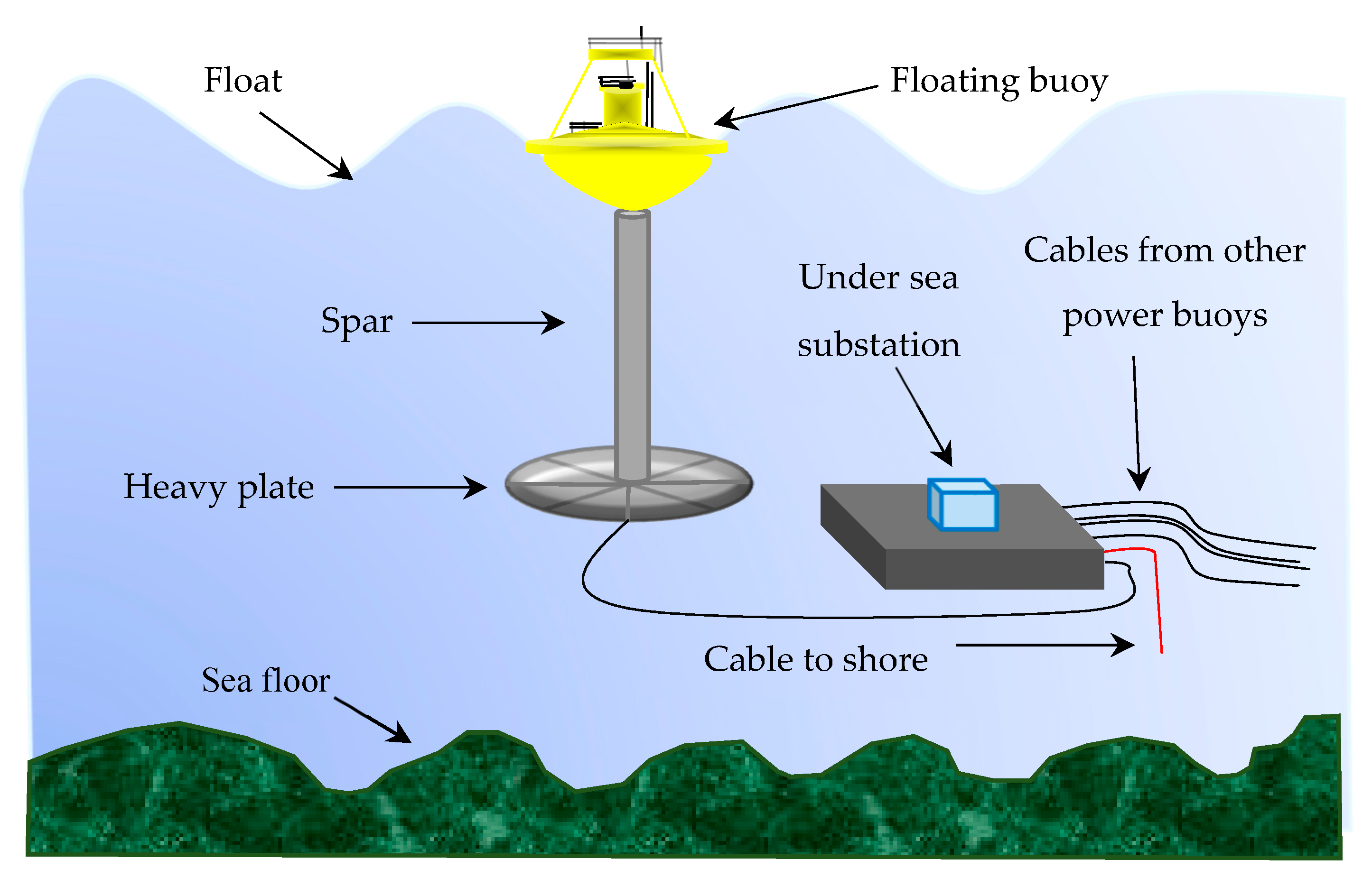
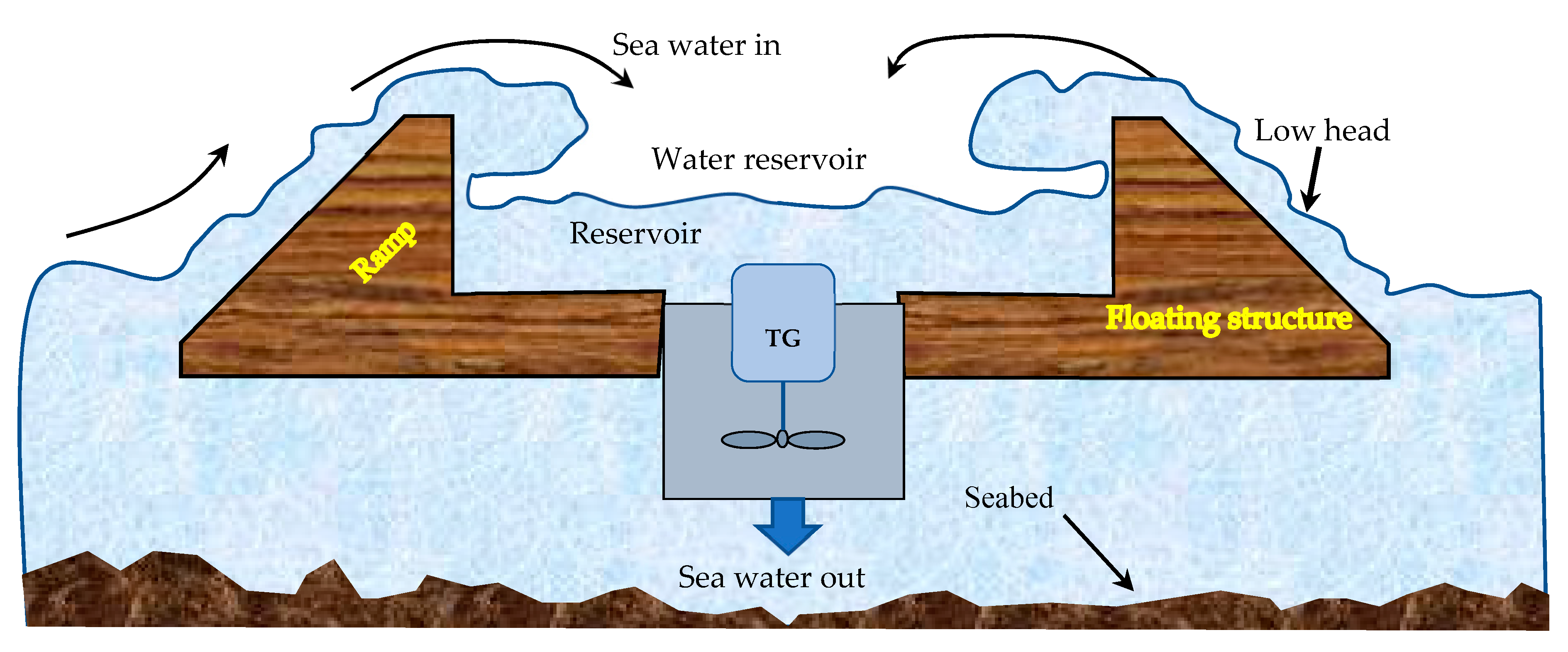
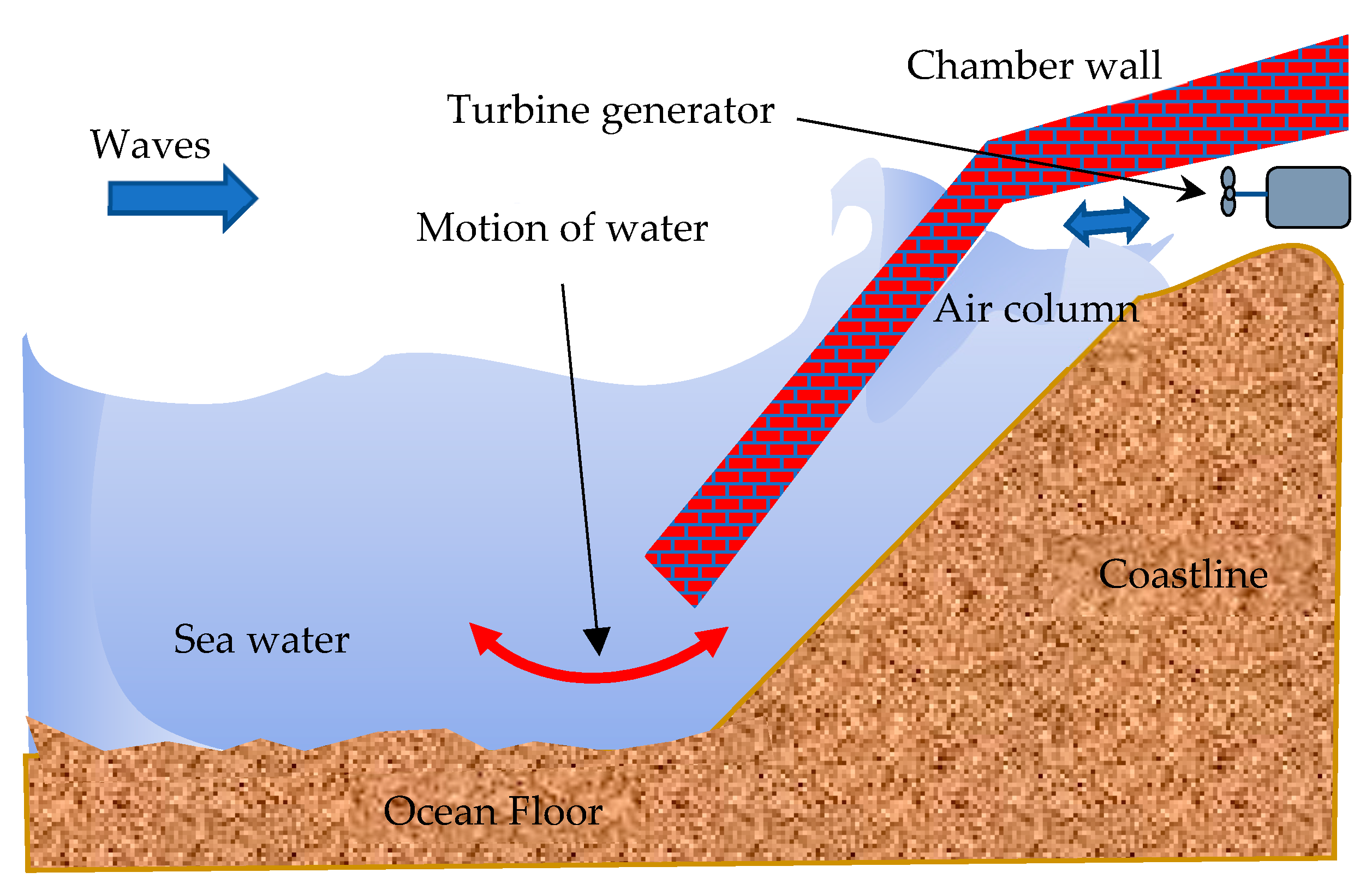
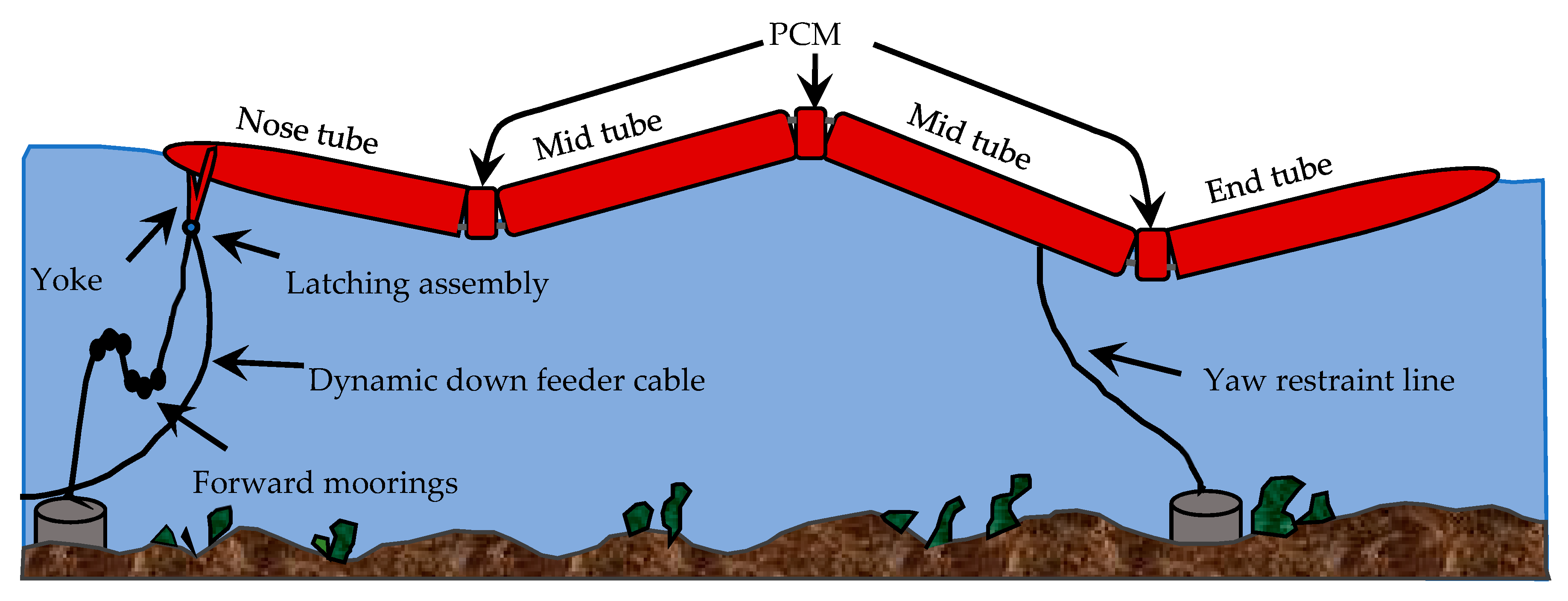
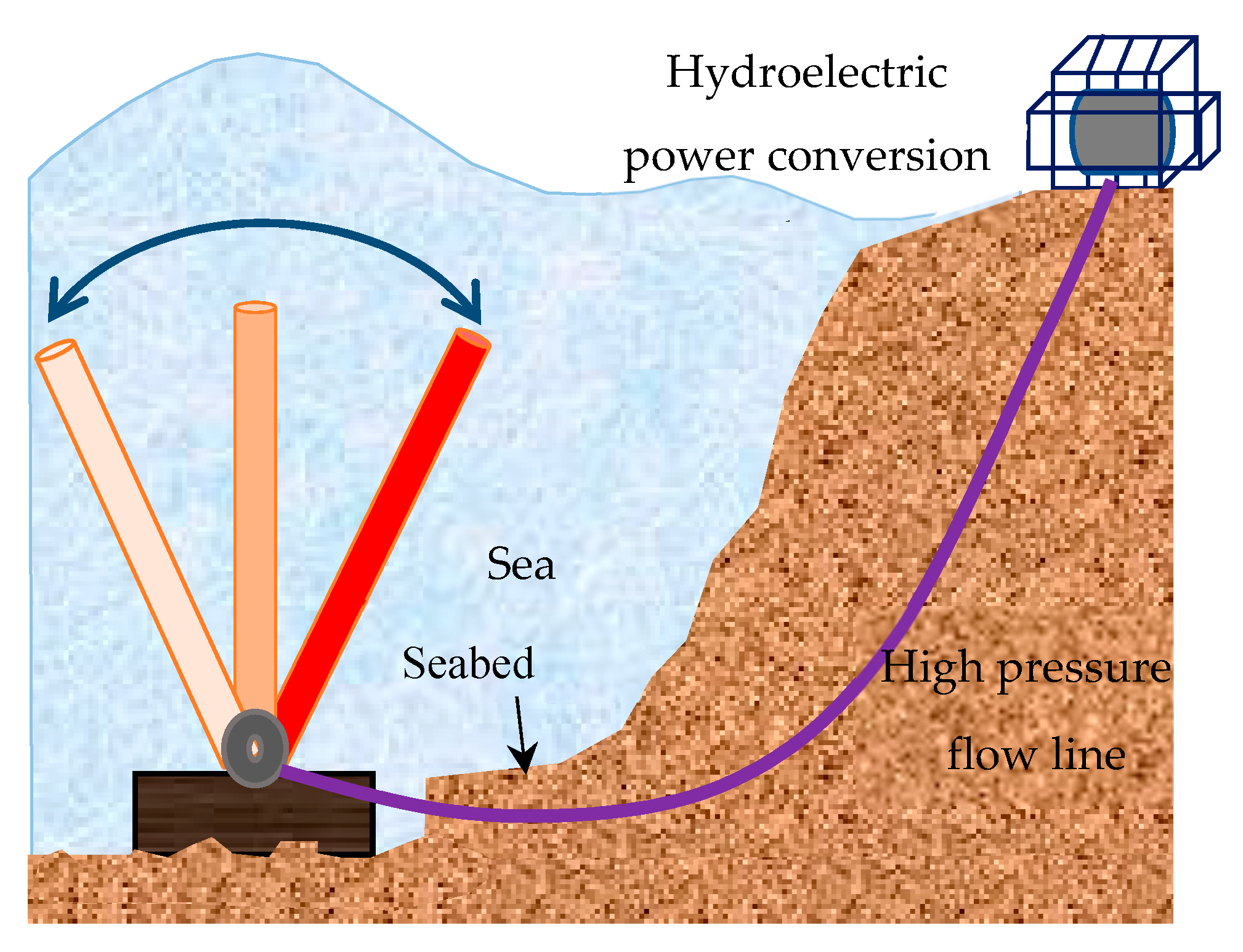

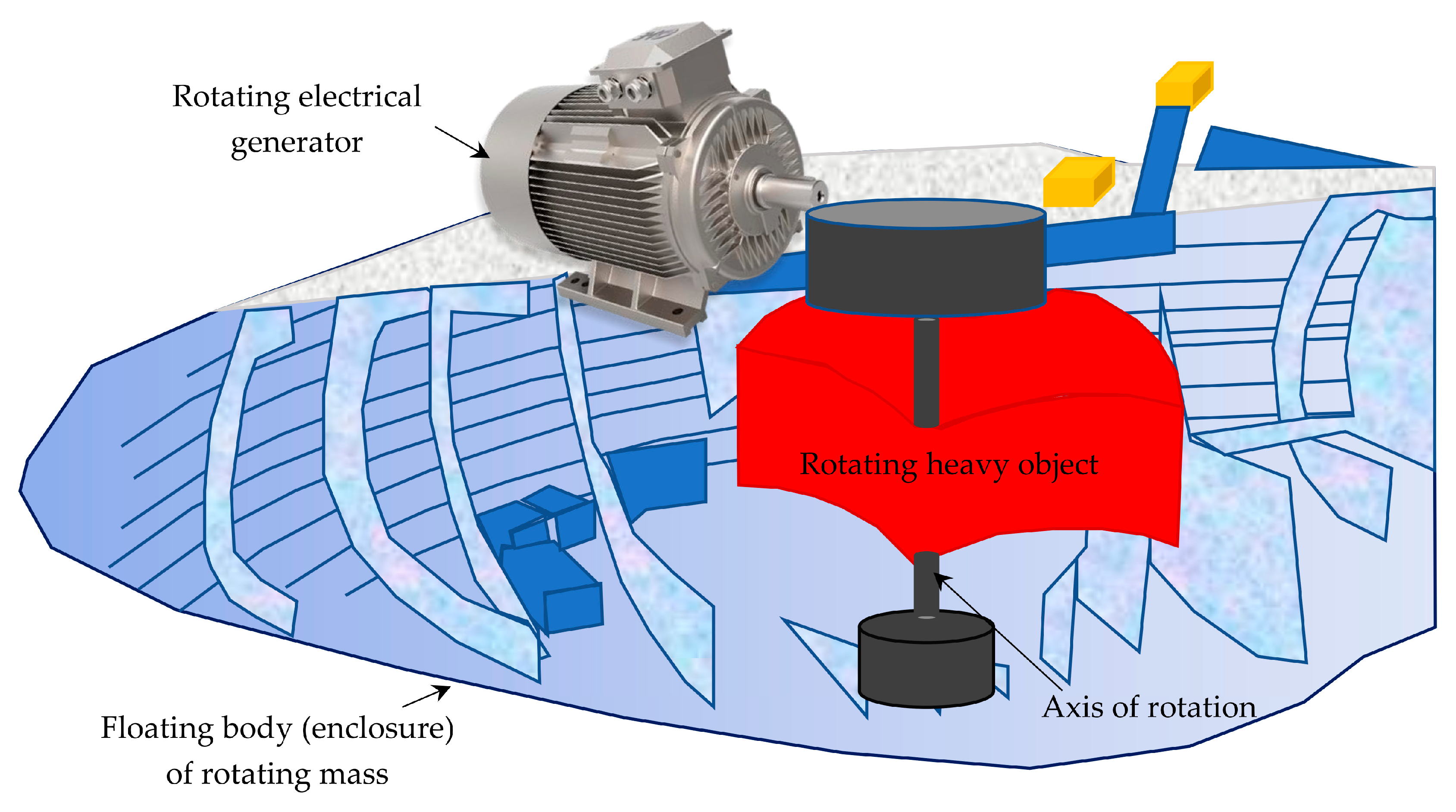
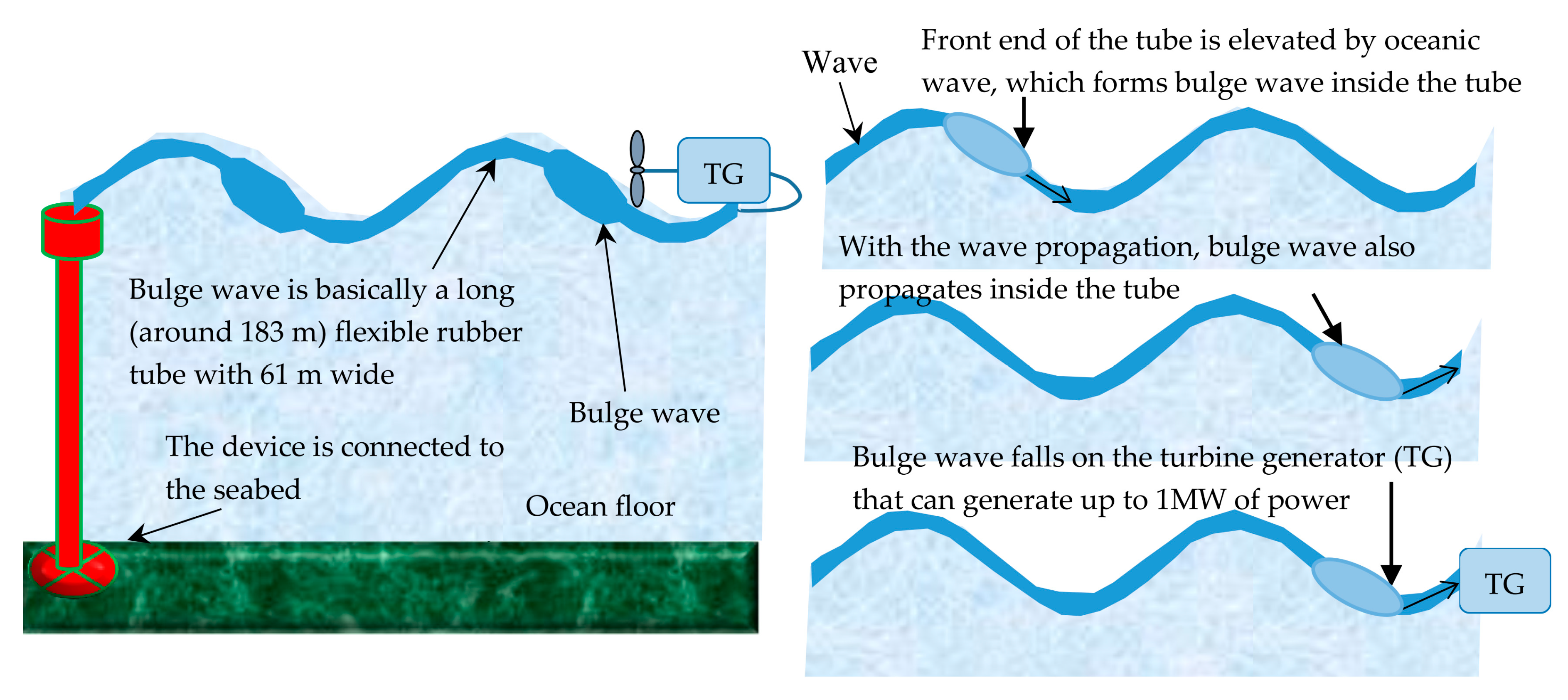
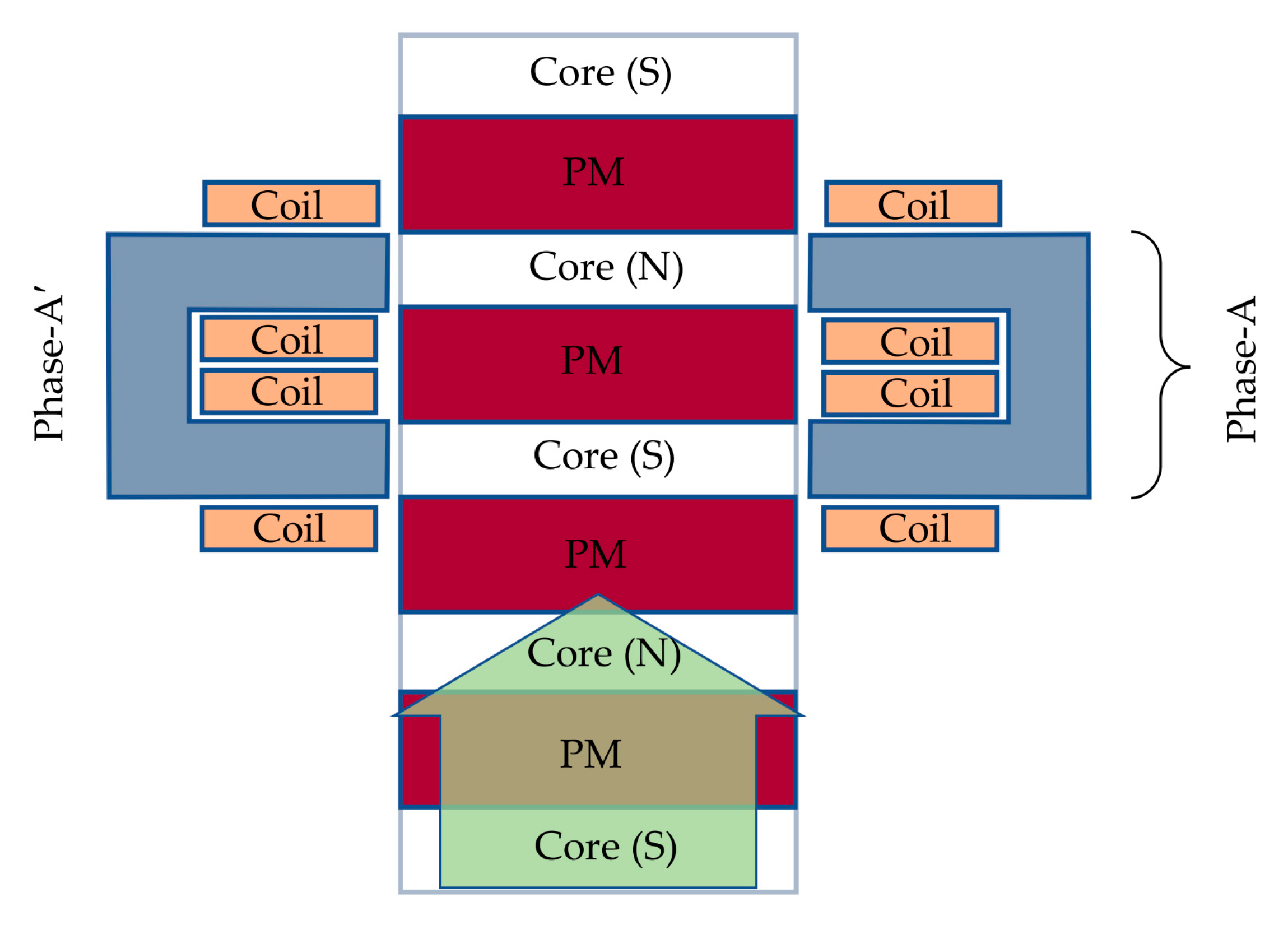
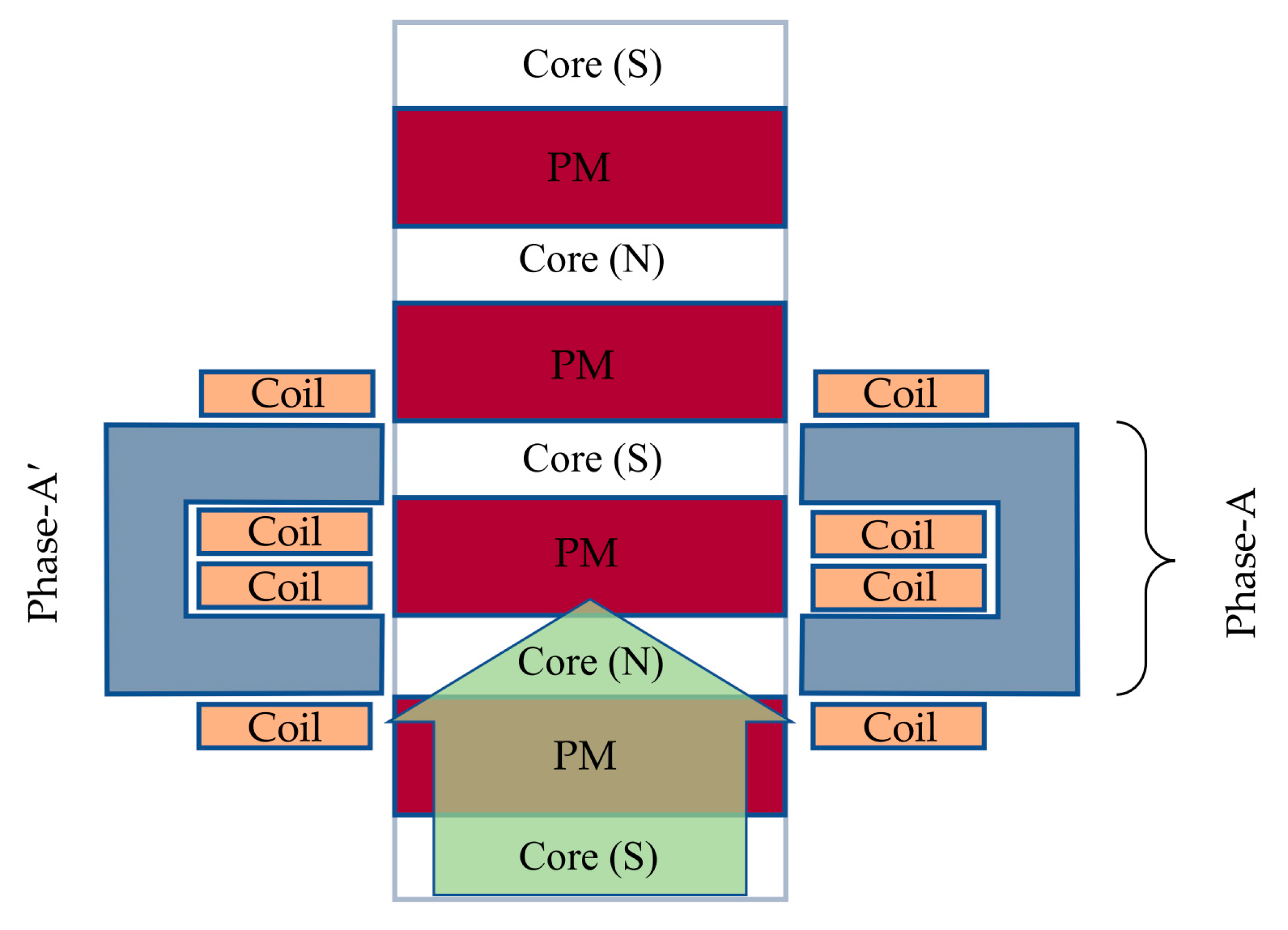
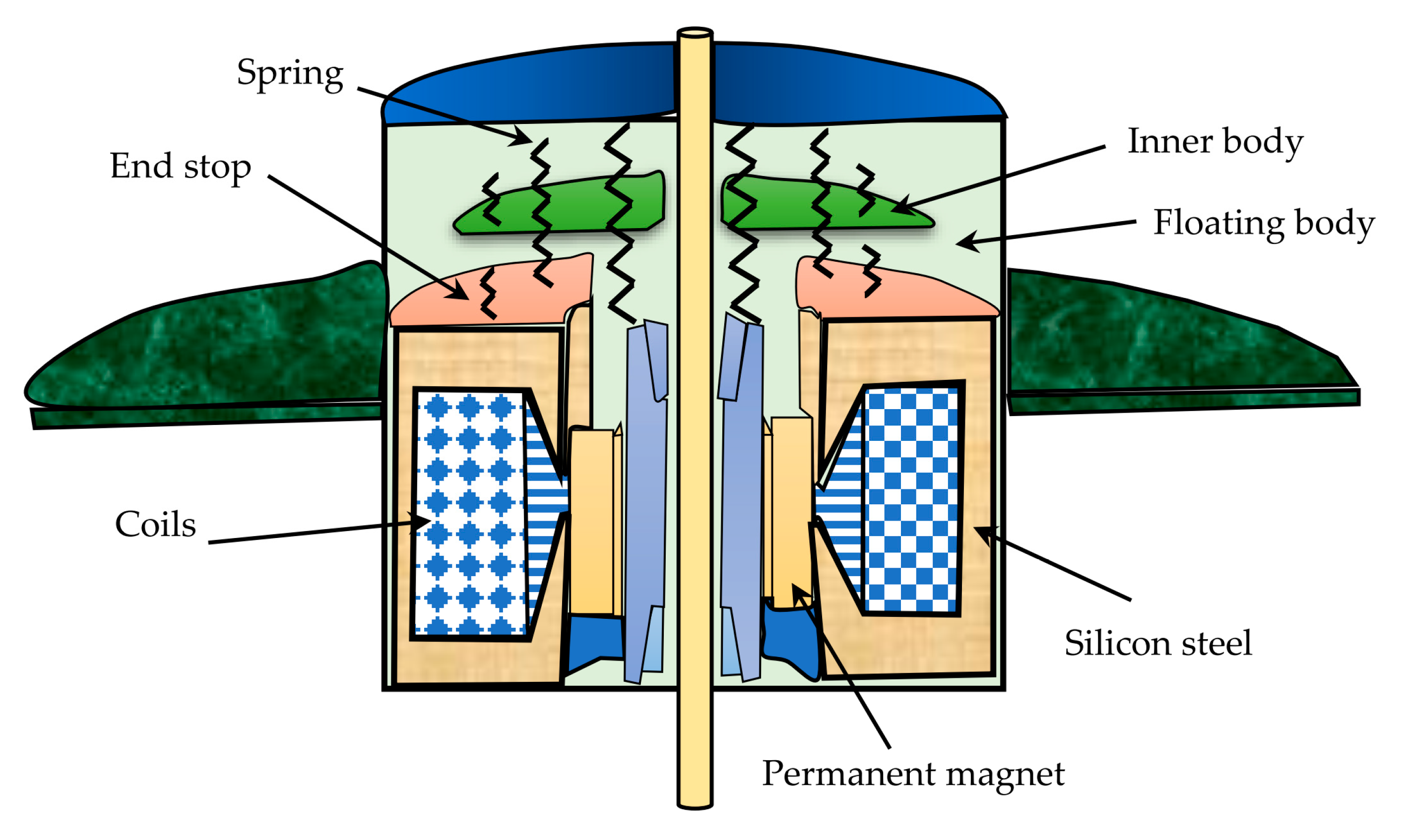

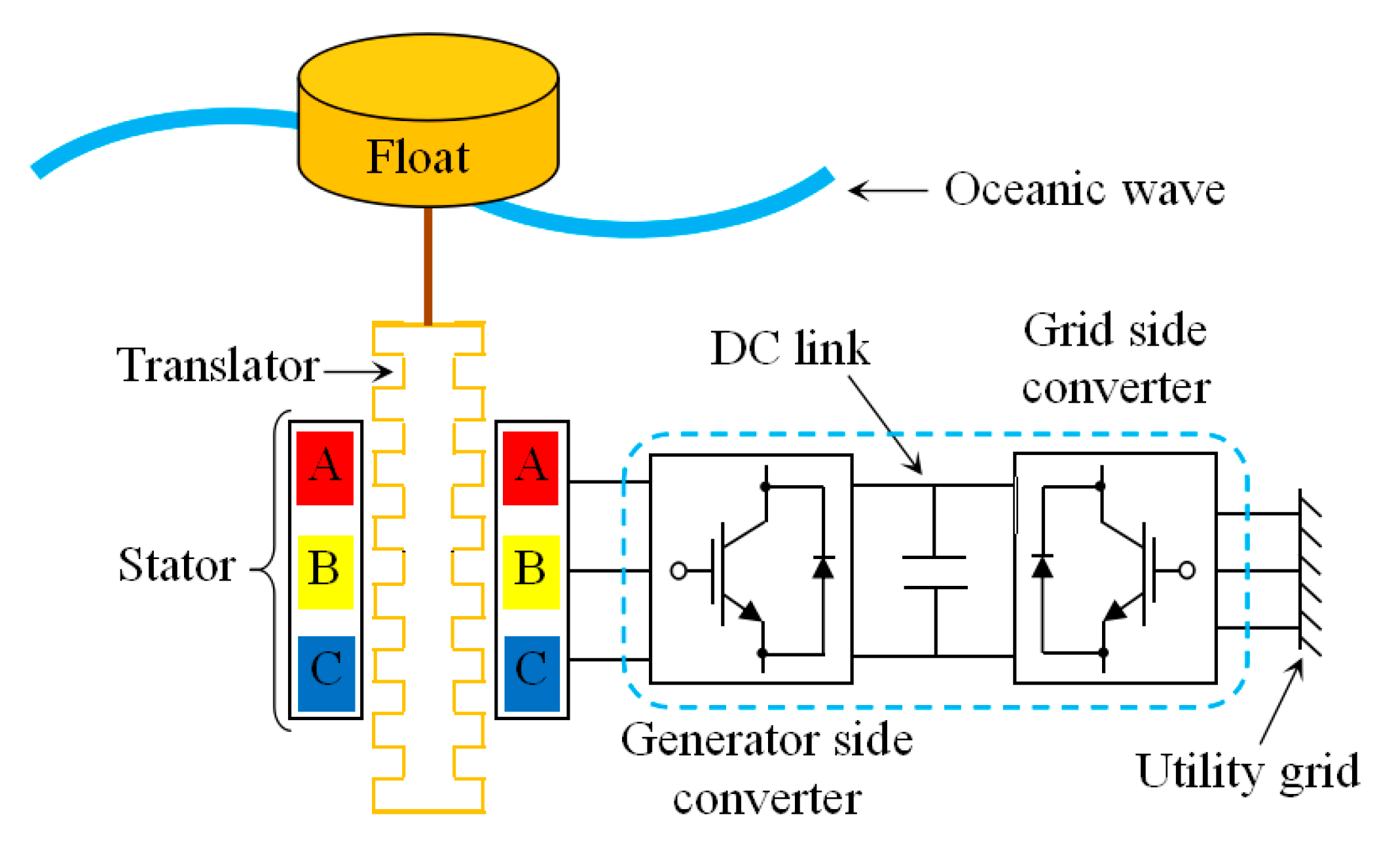
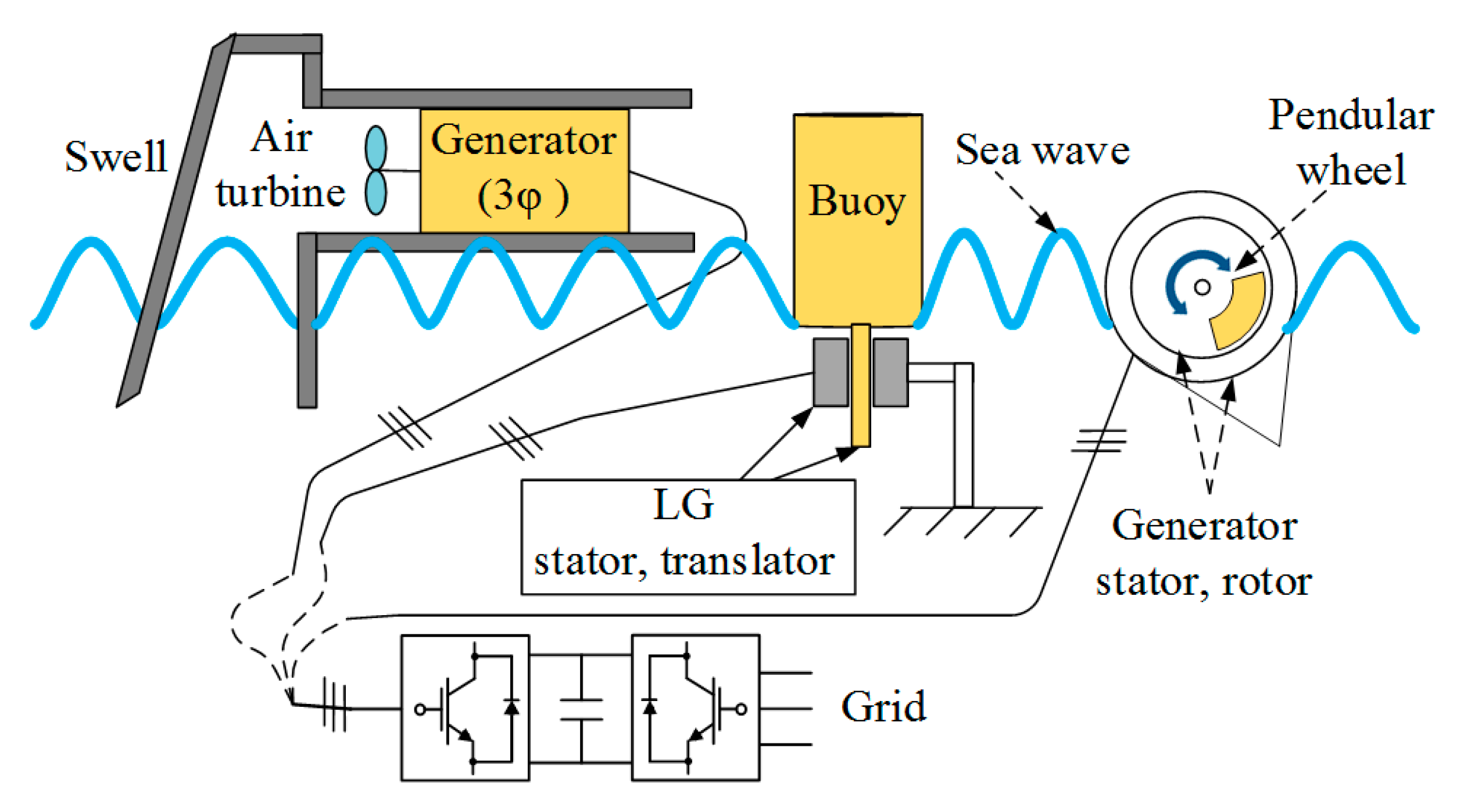


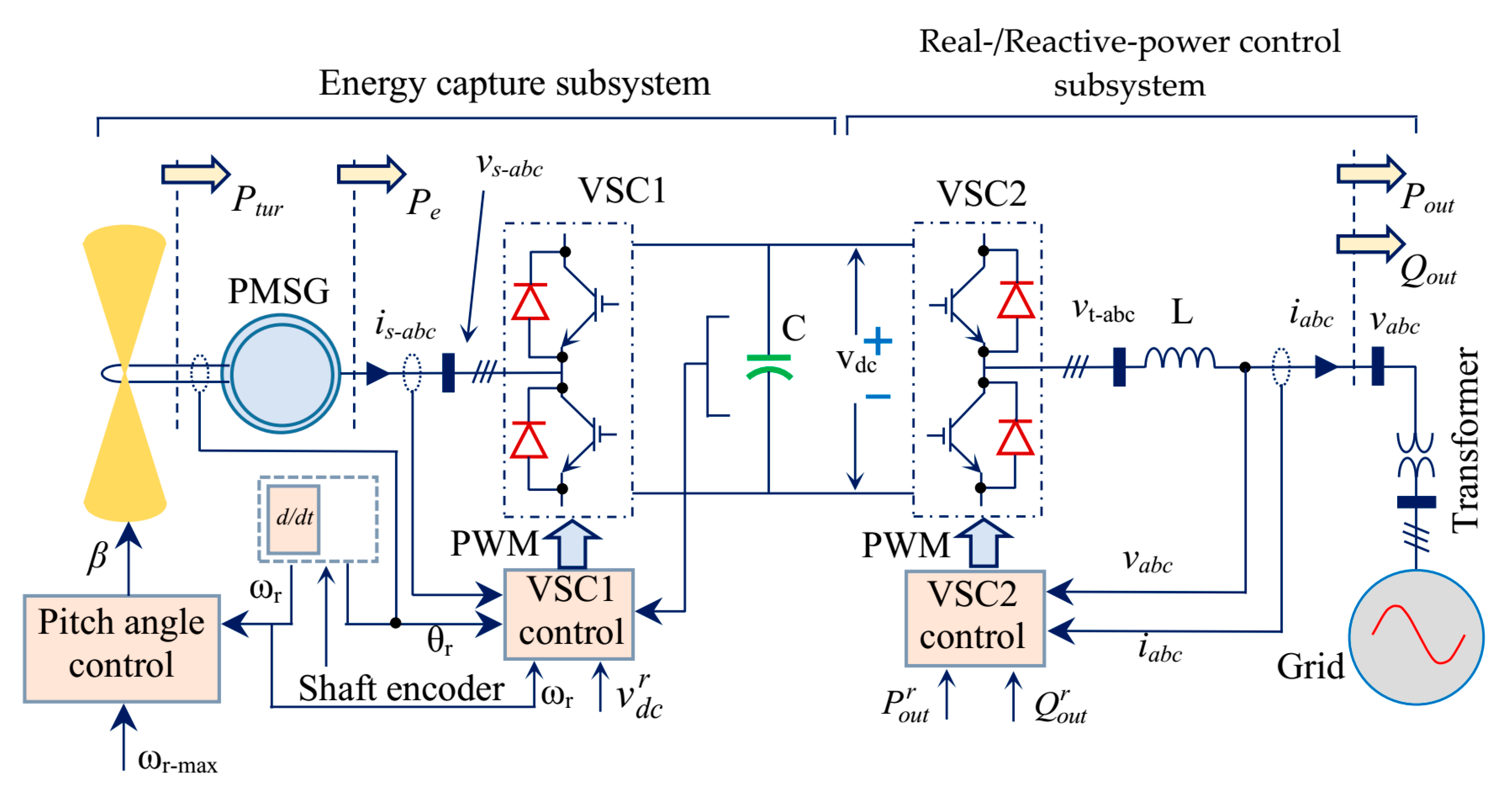
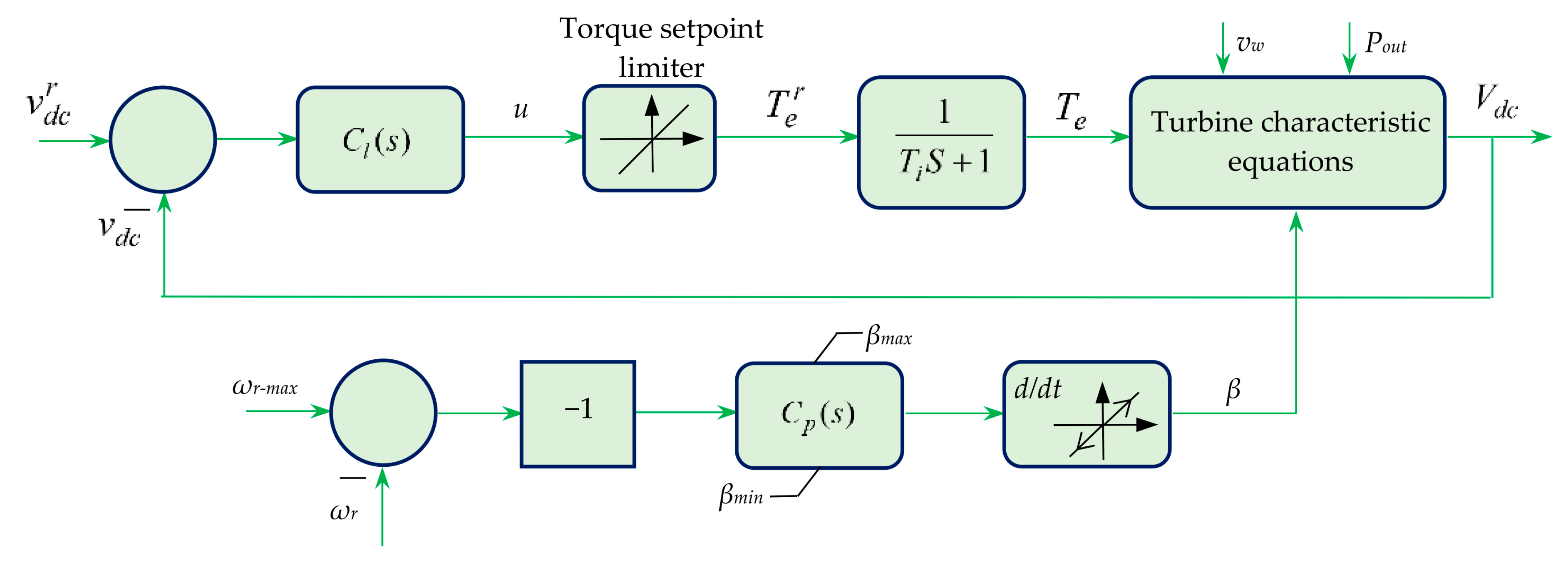
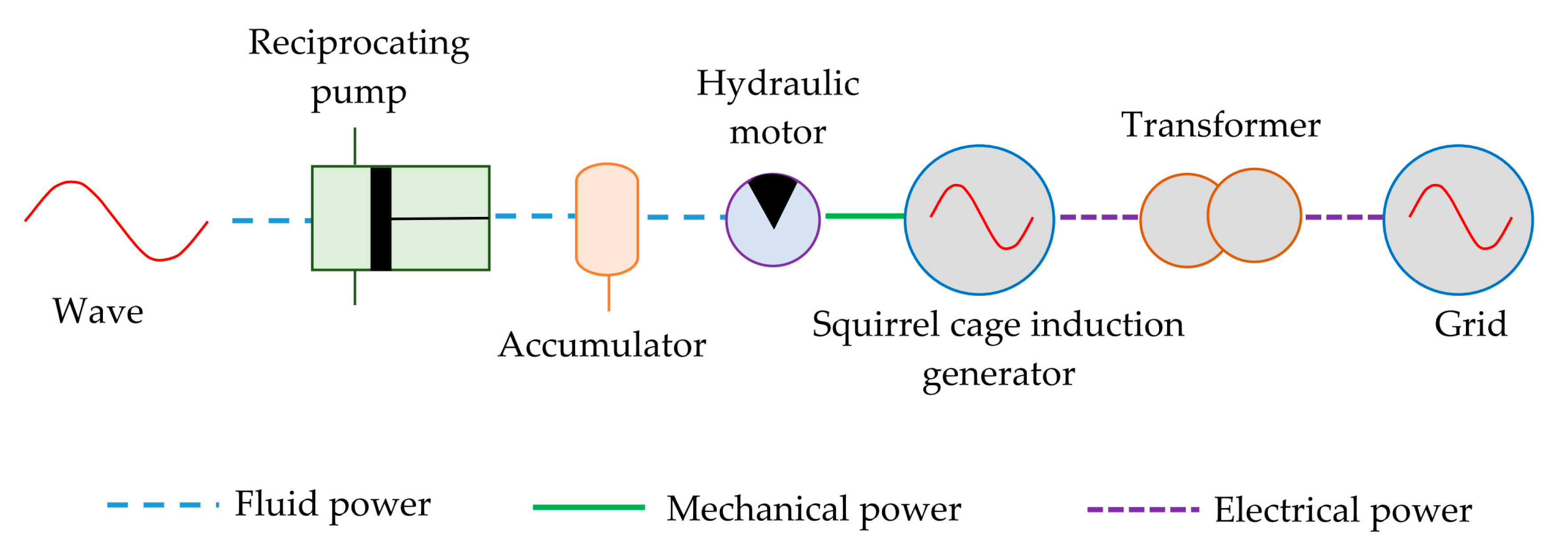
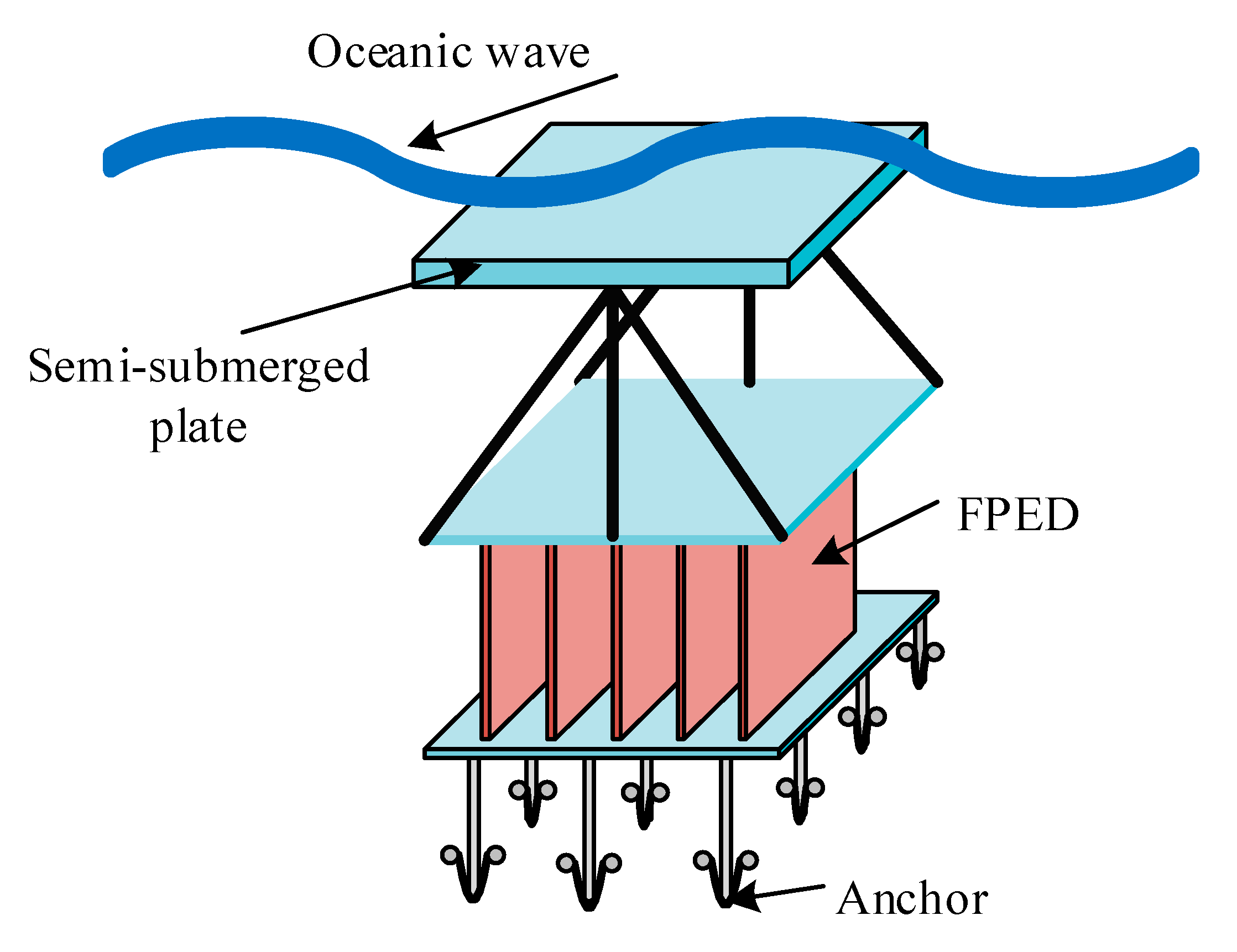
| Country | Wave Energy Potential (TWh/Year) | |
|---|---|---|
| Offshore | Near Shore | |
| UK | 43–64 | 14–21 |
| Ireland | 21–32 | 7–11 |
| Portugal | 12–18 | 4–6 |
| France | 12–18 | 3–5 |
| Spain | 10–16 | 3–5 |
| Italy | 9–16 | 3–5 |
| Denmark | 5–8 | 2–3 |
| Greece | 4–7 | 1–2 |
| Germany | 0.9–1.4 | 0.3–0.5 |
| RESs | Year-2017 | Year-2018 |
|---|---|---|
| Hydropower (GW) | 1112 | 1132 |
| Wind power (GW) | 540 | 591 |
| Solar PV (GW) | 405 | 505 |
| Bio-power (GW) | 121 | 130 |
| Geothermal power (GW) | 12.8 | 13.3 |
| Concentrating solar thermal power (GW) | 4.9 | 5.5 |
| Ocean power (GW) | 0.5 | 0.5 |
| Total (GW) | 2196.2 | 2377.3 |
© 2020 by the authors. Licensee MDPI, Basel, Switzerland. This article is an open access article distributed under the terms and conditions of the Creative Commons Attribution (CC BY) license (http://creativecommons.org/licenses/by/4.0/).
Share and Cite
Farrok, O.; Ahmed, K.; Tahlil, A.D.; Farah, M.M.; Kiran, M.R.; Islam, M.R. Electrical Power Generation from the Oceanic Wave for Sustainable Advancement in Renewable Energy Technologies. Sustainability 2020, 12, 2178. https://doi.org/10.3390/su12062178
Farrok O, Ahmed K, Tahlil AD, Farah MM, Kiran MR, Islam MR. Electrical Power Generation from the Oceanic Wave for Sustainable Advancement in Renewable Energy Technologies. Sustainability. 2020; 12(6):2178. https://doi.org/10.3390/su12062178
Chicago/Turabian StyleFarrok, Omar, Koushik Ahmed, Abdirazak Dahir Tahlil, Mohamud Mohamed Farah, Mahbubur Rahman Kiran, and Md. Rabiul Islam. 2020. "Electrical Power Generation from the Oceanic Wave for Sustainable Advancement in Renewable Energy Technologies" Sustainability 12, no. 6: 2178. https://doi.org/10.3390/su12062178
APA StyleFarrok, O., Ahmed, K., Tahlil, A. D., Farah, M. M., Kiran, M. R., & Islam, M. R. (2020). Electrical Power Generation from the Oceanic Wave for Sustainable Advancement in Renewable Energy Technologies. Sustainability, 12(6), 2178. https://doi.org/10.3390/su12062178






